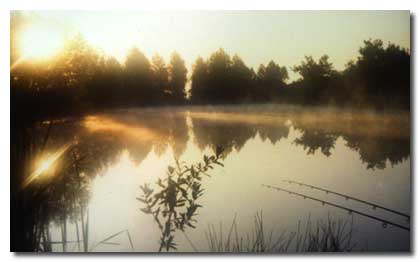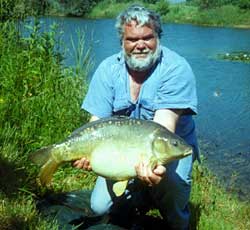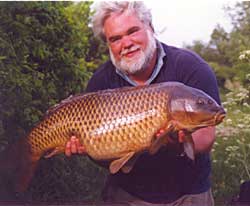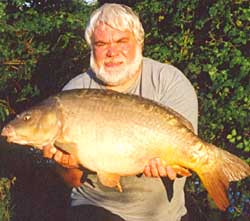Such mornings of clarity and crispness and the preceding hours tucked up in my sleeping bag spent listening to the magnified sounds of the night have, throughout my later life, provided an oasis of tranquil sensibility away from the cacophony of day to day living. Many is the time I have found solutions to the complexities of personal and professional problems by distancing myself from reality and seeking refuge in this enchanting world. Perhaps, from what I am saying, readers would surmise that the last thing I need to take with me for such escapism is a matching sets of rods, bite alarms and illuminating indicators. Perhaps just the bivvy, bedchair and sleeping bag is all that is needed to capture those reflective and enlightening moments. Not a chance. It is the electric anticipation that at any moment the alarm will sing, the rod will develop a life of its own and the challenge has been accepted by a hidden leviathan that gives the sharpness of thought and at times prevents complete capitulation to the demands of sleep. Many is the time I have put the world to rights in the small hours. This is the story of my therapy. No counsel but my own silence. No medication but the intoxication of balmy summer nights, the sound of heavy autumn rain on the bivvy and sight of frost’s winter filigree on intricately spun spider’s webs. Maturing years change priorities as the wildebeest migrate It wasn’t always like this. Perhaps maturing years have changed my priorities when fishing. I started my lifetime carp adventure back in the mid seventies on one of the most crowded carp waters in Essex. I won’t mention its name but those in the know will easily identify with the carp angler culture that pervaded and still pervades this popular pit. The water opened its gates at 6 am and all hell would break loose with a scene not unlike the wildebeest migration on the Serengetti. In those days the queue of cars waiting for the six o’clock rush hour would, on a Saturday, stretch for several hundred yards. At the very front of the queue, not just on Saturdays but on Sundays, Mondays, Tuesdays, Wednesdays, Thursdays and Fridays as well would be a teenager who is now a household name in carp fishing circles. He and his mentor would drive out of the gate at closing time, turn the car round and park in the gate entrance for the night.
I learned to be different, to experiment and to persevere I learnt to be different, to try the less obvious and to be willing to experiment. I learnt that you have to make things happen and that you cannot expect instant success because you have all the latest, state of the art tackle. I also learnt that the only bit that really matters is what’s below the surface, an adage which not only applies to fishing. I also learnt to persevere when others around me came and went. I became a long stay carp angler in the sense that I am still at it some 30 years later unlike the short trip carp technophobe who, kitted out with every conceivable carp gadget spends a couple of seasons keeping up with fishing fashion only to become bored and sell his collection lock stock and barrel after his first encounter of the feminine kind. What I am saying is that it is not the science and technology which makes the angler consistently successful. In fact I would go as far as to say that you can have all the science and technology in the world at your disposal but if you do not have the art and do not appreciate the aesthetic aspects of the pursuit of the carp then it is unlikely that it will become a lifetimes passion. Where do you find the art, and what is it? So where does this art come from? Art is about feelings, emotions and intuition. It is the combination of observing, listening and hearing, reflecting and experiencing. It comes from the personal experiences of years and years of getting things right and more often getting it wrong. However I would argue that I learnt the art of carp fishing when in 1986 I finally broke away from my safe corners on the popular Essex pit and found a water where the carp had never been exposed to such high tech wizardry. And it all happened because of a perchance comment from an unlikely source.
It was following my other passion in life, which is playing and watching rugby union. There I was on a freezing cold November Saturday afternoon having my face ground into the earth at the bottom of a collapsed scrum when a voice piped up “Bloody hell,” or words of a similar ilk. “Why didn’t I go fishing instead”. Well, in the bar later the owner of the voice and I got talking, one thing led to another and six days later on the Friday afternoon I found myself driving down narrow Essex country lanes with my new fishing companion as he took me to “this great little lake that I know. It’s full of lovely carp which no one fishes seriously for.” It was the silence I noticed first The first thing I noticed about Gatehouse was the silence. We were alone. Gone were the rows and rows of identical, perfectly balanced and aligned carp kits. The water wasn’t being whipped to froth with lead after lead and spod after spod winging their way to the horizon. Instead there was a still tranquillity made even more evident by the stark bare trees silhouetted against the watery winter sunset. And yet the electricity of that first encounter lives with me to this day. What secrets lay in the silver-plated depths of this magical place. “So how do you fish this?” I enquired of my companion.
My first encounter with an Italian Mirror of exquisite beauty That night saw me catch five carp to 17lbs with the biggest being my first of many encounters with an Italian mirror of exquisite beauty. Despite the hundreds of carp that I had taken over the years from the wildebeest stamping ground, this fish meant more to me. It was perfect in every way. It was fresh, clean and pristine and it fought all the way to the net. And it was also the first time I had spent the whole night fishing. The morning said it all for me. The bushes and dying reeds were encrusted in a tiara of frost, fingers of ice reached out from the water’s edge and the bright winter dawn showed me what I had been missing for all of those years. There was no going back for me. The Serengette stampede was a thing of the past. It was here that I would discover the art. This was my kind of fishing. I found refuge as well in the magical place Not only did I learn the art of fishing in this magical place but I also found refuge from stressful facets of my life. In the late eighties I encountered the debilitating power of depression and it was only 4 months in the refuge of Gatehouse that I found peace of mind and solutions to my problems. Then in 1994/5 I found myself single again after my marriage break-up and once again Gatehouse became my refuge. Long summers and even longer winter nights provided the chance to recharge my batteries.
I returned there the other weekend. It was a cold October night. The mist crept into by bivvy as dawn arrived. I quickly got out of my cocoon and warmed myself with a cup of tea. I woke my son from his slumbers at the other end of the lake and said to him, “I’ve got an old friend in the sack.” “Not the Italian!” he exclaimed. “Yes, the Italian.” I replied. She went 25lb 8oz. I hadn’t lost the art. |
Welcome!Log into your account


















